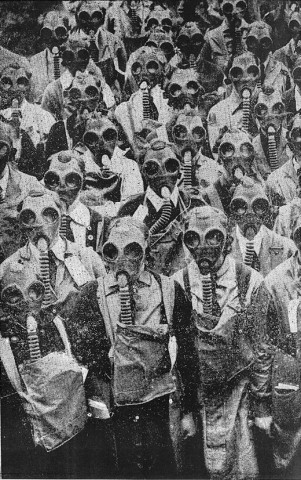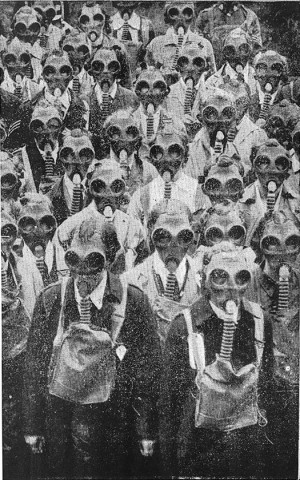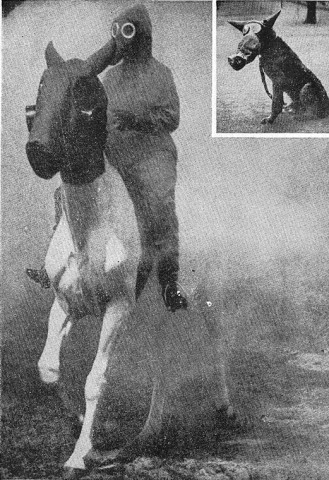The above photograph, and all of the following, are from Poison Gas (London: Union of Democratic Control, 1935).

SAVING THE BABY. -- M. Jean, of Paris, observed that ordinary gas masks had the effect of strangling babies and small children. So he proposes to sew them up in an old cow's hide on the principle shown above. Father stands by -- if still alive -- and pumps fresh air into the skin.
TRAINING THE YOUNG. -- Training the young to use gas masks, which may or may not be effective in the horrible future which is before them if the present war propaganda is successful. Notice the children's bare legs, entirely unprotected against the two most probable gases -- mustard gas and Lewisite.
MUZZLED FOR WAR. -- These masks will be no more effective for animals than they are for human beings. And no government has yet suggested any scheme for training animals to use gas masks.
![]() This work is licensed under a Creative Commons Attribution-NonCommercial-NoDerivatives 4.0 International License.
Permissions beyond the scope of this license may be available at http://airminded.org/copyright/.
This work is licensed under a Creative Commons Attribution-NonCommercial-NoDerivatives 4.0 International License.
Permissions beyond the scope of this license may be available at http://airminded.org/copyright/.





Jakob
I want my mummy...
Martin W
Highly interesting photos. In a way the mood of these "instructional" images reminds me a lot about 1950s movies about how to act in case of nearby nuclear attack. The propaganda message is similar in both cases, indicating that the government cares and that if you only follow the instructions you will be doing fine. The prevailing feeling, however, is that of hopelesness and desperation rather than protection.
In my opinion the fact that poison gas wasn't used during WW2 is one of the few miracles of that conflict. The fact that it never happened is perhaps especially interesting in the light of Douhet's theories, which are widely claimed to have inspired both the German and the Allied conduct of air war. If I remember correctly, in Douhet's book, a decisive blow in the future war comes through aerial gas attack on major cities.
I keep thinking thet perhaps Douhet's doctrine wasn't as influential as today's historians would like to make it.
Brett Holman
Post authorJakob:
LOL. That reference did occur to me too ...
Martin:
In this case, the feeling of desperation is increased by the captions: the UDC argued that there was no effective defence against poison gas, whatever the government said, which was a pretty common pacifist position in the mid-1930s.
I would agree that Douhet's influence has been exaggerated, at least in Britain, but more because he's unnecessary: others were thinking along much the same lines, long before his ideas were discussed in English. It's true that he predicted the liberal use of gas in attacks on cities (as did many writers, of course), but the job of destruction would also involve high explosives and incendiaries. Of course, he greatly over-estimated how effective all this would be, and how damaging to morale (again, so did most people).
Martin W
Brett,
I read your previous article about Douhet with great interest; I wasn't aware that you have already covered the topic. You analysis confirms my own suspicion that alleged Douhet's profound influence on military minds of the era which can be read about in just about any WW2 aviation book wasn't true. Indeed, it looks more like someone's thesis had been repeated by a chain of other authors.
Len Deighton's remark in his "Fighter" that Douhet was "often quoted but seldom read" got me thinking; for example, how and when was his book translated to other languages? Did he w´publish anything else on the subject? Was his name widely recognized in military circles?
Furthermore, my understanding is that Douhet's book was aimed at popular reader rather than professional military theorists; it should have made his work easy to ignore by the "serious" military. Also because of this, it is unlikely that he made up everything himself; there must have been other thinkers of the time that served as an inspiration - who were they? etc.
You article brought complete or partial answers to many of these questions, which is has been of great help.
It's all interesting to me because I've been studying the development of RAF Fighter Tactics in the years preceding World War II; the tactics which assumed fighters combating unescorted bomber and thus made itself famous for its inefficiency in the face of the Luftwaffe over England and then, for example, over Malta.
Keep up the good work
/Martin
http://www.spitfiresite.com
Brett Holman
Post authorYes, those are all questions I'd like answers to as well! I think you're right: the idea of Douhet's significance has often just been repeated without much thought: it's something that everyone knows, so doesn't require any evidence. BUT, I can really only speak to the British case. Historians who I find quite to be quite thorough have discussed the matter of Douhet's influence in other countries and he does seem more important (see eg James Corum's The Luftwaffe and Scott Palmer's Dictatorship of the Air). My guess is that Douhet was just saying what a lot of airmen were already thinking, in a popular form which politicians and other civilians could be pointed to. But in Britain, he wasn't read until he wasn't necessary, I guess because of the RAF's early adoption of the primacy of the bomber.
Izzie
jeez....
steph
haha that baby doesnt look happy!
it looks like a really old baby.... look carefully at his face
:P
steph
poor horse.....
Pingback:
Totalitarian Art - World War II Forums
lozzie
the aileans have invaded!!! lol
lozzie
i love horses but putting something like that on them was just sad.
mmmm........... :)
lozzie
BLOOMING NORA
jose
dats dope the people are all deep redy to go bombming even the horses r 2
rayner
YES.
Brett Holman
Post authorI can now provide some context for the top two photos (which are actually two halves of the same photo). A differently-cropped version appears in the News Chronicle, 22 May 1935, with the following caption:
J Ptak
Excellent--thanks.
Brett Holman
Post authorAnd a version of the baby 'gas bag' appears in the Daily Mirror, 15 May 1935, 7. The caption is:
Ray
well there were far more common chemicals than chlorine or mustard gas. so the masks did protect "humans" to a certain degree. horses or other fur animals would not have this advantage , because of there fur witch does not have as much oil on the outside like our human skin does , in witch our skin creates a seal. but the testing of the cow hide is not totally effective against radiation but may and is probably safer than the gas masks are against mustard gas and chlorine
Brett Holman
Post authorI'm not sure what you mean by 'far more common chemicals than chlorine or mustard gas', as these were two of the most used gases in WWI. (The other one would be phosgene.) The masks protected against breathing in gases such as chlorine and phosgene, but not against contact, and that was how mustard gas did its damage.
Interesting what you say about fur being less effective protection than human skin, but then the latter was no protection against mustard gas.
Pingback:
Airminded · New horrors of air attack
D00med
There is no hope for the human race.
Brett Holman
Post authorYou're probably right. In the long run, we're all extinct.
Erik Lund
So can I have your liver, then?
Brett Holman
Post authorNot yet.